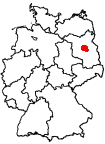-
Crossroads of European Culture
and History
On April 2nd, 1930 the North German Lloyd
Company's ship "Bremen" set sail from Bremerhaven to New York. A glimpse
at page 2, line nr. 14 of the passenger manifest immediately catches
ones eye. Ones attention is drawn to an entry which lists a young woman
from Berlin. Her vital statistics read as follows: Family name: Sieber.
Maiden name: Dietrich; Forename(s): Marie Magdalene (Marlene); Age: 25;
Occupation: Actress; Going to: Paramount Film Corp., Hollywood, Cal.
This could certainly not be considered a typical emigration case. How could
it have been, with all the media swarming around her upon her departure
? Dietrich would eventually take on American citizenship. Her last
days,however, were spent in Paris, before finally being layed to rest in
Berlin in a cemetery on the Stubenrauchstrasse.
19th century emigrants from Berlin were
not usually like the displaced or destitute emigrants from other regions.
They were not primarily interested in acquiring land or work. Figures like
Dietrich typified the emigrant from Berlin, even if not all of them went
on to become as famous. Such personalities included artists and intellectuals,
or just international career people - those individuals persecuted for
their political or religious beliefs would soon follow. These included
people like the filmmaker Ernst Lubitsch, architect Walter Gropius, and
the journalist Manfred George, founder of the German- Jewish weekly "Aufbau",
among others.
Berlin happened to be the most important transit
station for millions of emigrants leaving eastern and southeastern Europe.
Routes from all over that part of the continent led to Berlin, where hundreds
of passengers arrived daily. In order to accomodate the masses, a train
station called Ruhleben was built on the outskirts of the city. It went
into operation on November 11th, 1891. Ruhleben was the very first processing
station to be conceived and operated on a joint basis by the HAPAG
and the North German Lloyd Companies. The aim of the project was to develop
a system of logistics, so as to eliminate overcrowding at any one European
port.
When Marlene Dietrich left Berlin the barracks
of Ruhleben were no longer in operation. She bid her farewell at the "Lehrte
train terminal" in Berlin..This station would soon become a major railway
hub. Today, Berlins new central station may be said to be Europe's most
modern railway terminal. It forms the underground nucleus of an intercity
express train network, which operates on multiple levels directly in the
heart of the city. This flagship project has succeeded in bringing Berlin
back to the status it once enjoyed before the Second World War, when it
was one of Europe's leading metropolitan cities. Classic German-American
themes throughout history, such as the Potsdam Conference, the Berlin Airlift,
the remains of The Wall or Checkpoint Charlie have taken on additional
significance since the German Reunification in 1989.

Research and Travel offers:
Guided tours in Germany
Research services for your roots in Germany
|

Ernst Lubitsch, born 1892 in Berlin, died 1947 in Hollywood.
|



